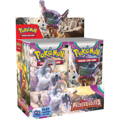Pokémon's Ting-Lu
Ting-Lu, a Legendary Pokémon introduced in Generation IX, possesses a unique dual typing of Dark and Ground. It is not known to evolve into or from any other Pokémon. Ting-Lu stands as one of the esteemed members of the Treasures of Ruin, alongside Wo-Chien, Chien-Pao, and Chi-Yu. Also known as Ruinous Legends, this quartet of Legendary Pokémon share a primary type, Dark, as well as the signature move Ruination. Their signature Abilities are all variations of each other, sharing the effect of lowering a certain stat by 25% for all Pokémon on the field except themselves when they are in battle.
Ting-Lu has been causing quite a stir as his image was seen on the Paldea Evolved booster box, along with his own booster pack art!
Biology of the Ting-Lu
Ting-Lu possesses a substantial stature, resembling a majestic creature reminiscent of a deer or a moose. Its body is constructed from layered rocks, exhibiting a range of hues from dark brown to a light tan. The head of Ting-Lu showcases distinct red markings, accompanied by small crimson eyes and a noticeable dewlap on its chin. Adorning its head is a prominent ritual vessel, visibly cracked down the center, adorned with an intricate rectangular pattern resembling eyes, and adorned with antler-like spikes along the rim.
Among the Treasures of Ruin, Ting-Lu's genuine form manifests as the ritual vessel atop its head. It attains life through the ancient human fears, while its physical body represents a manifestation crafted through its mastery over the earth. Remarkably, Ting-Lu possesses the incredible ability to create colossal fissures reaching depths of over 160 feet (50 meters) merely by gently lowering its head to the ground. It is aptly recognized as the Vessel of Ruin.
Intriguingly, Ting-Lu and its fellow Treasures of Ruin hold the distinction of being the exclusive Pokémon capable of mastering the powerful move known as Ruination. Furthermore, Ting-Lu alone possesses the unique Vessel of Ruin Ability, setting it apart from all other known Pokémon.
Card Release Information
This card was included as a Regular card, a Full Art Secret card, a special illustration rare, and a gold etched Hyper Rare in the Paldea Evolved expansion, first released in the Japanese Clay Burst expansion. The Regular, Full Art, and Hyper Rare prints feature artwork by 5ban Graphics, while the special illustration rare print features artwork by KEIICHIRO ITO.
Origins of Ting-Lu
Ting-Lu draws inspiration from various members of the deer family, including the moose, elk, and Père David's deer, the latter being indigenous to China. Notably, the fractured vessel atop its head is reminiscent of the broad, palmate antlers seen in Eurasian elk. Additionally, the allusion to Ting-Lu's remarkably heavy head in the Pokédex entry suggests a connection to the Irish elk, an extinct cervid renowned for bearing the largest antlers among deer species. The overall design of Ting-Lu may also pay homage to Chinese stone sculptures found along sacred paths leading to tombs and mausoleums, as well as the deer stones adorning the Eurasian Steppe. Furthermore, the horizontal stripes adorning its body mimic the stratification seen in sedimentary rock formations.
The vessel adorning Ting-Lu's head takes inspiration from the ancient Chinese cauldron called a dǐng, which held great symbolic value as a representation of imperial authority. The incorporation of deer and dǐng elements together may allude to the phrases wèndǐng (meaning "to inquire about the cauldron") and zhúlù (meaning "to hunt for deer"). These phrases evoke the concepts of power struggles and aspirations for the throne.
Ting-Lu, alongside the other Treasures of Ruin, potentially draws inspiration from the Four Perils of Chinese mythology, specifically Taotie, a voracious creature commonly depicted in ancient bronze vessels, and Qiongqi, occasionally portrayed as a savage deer.





